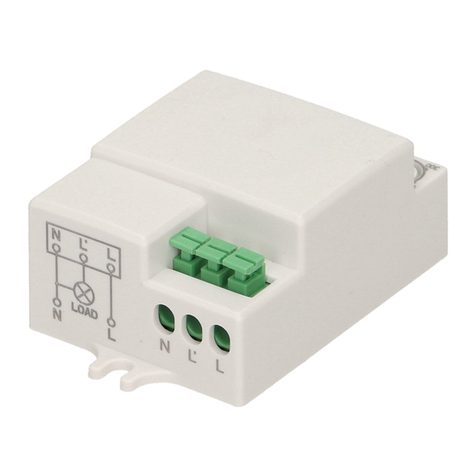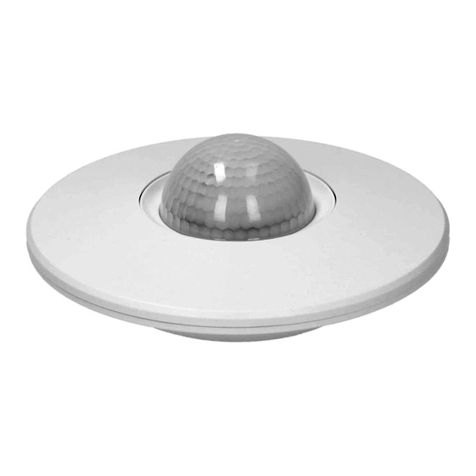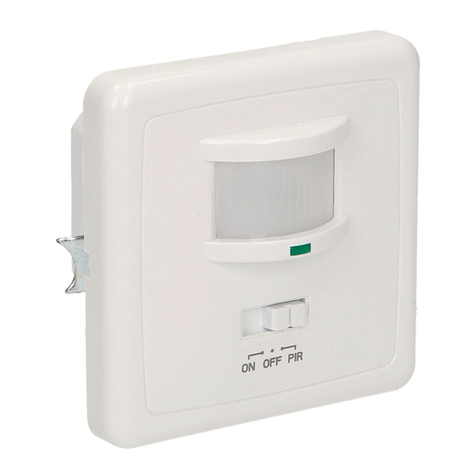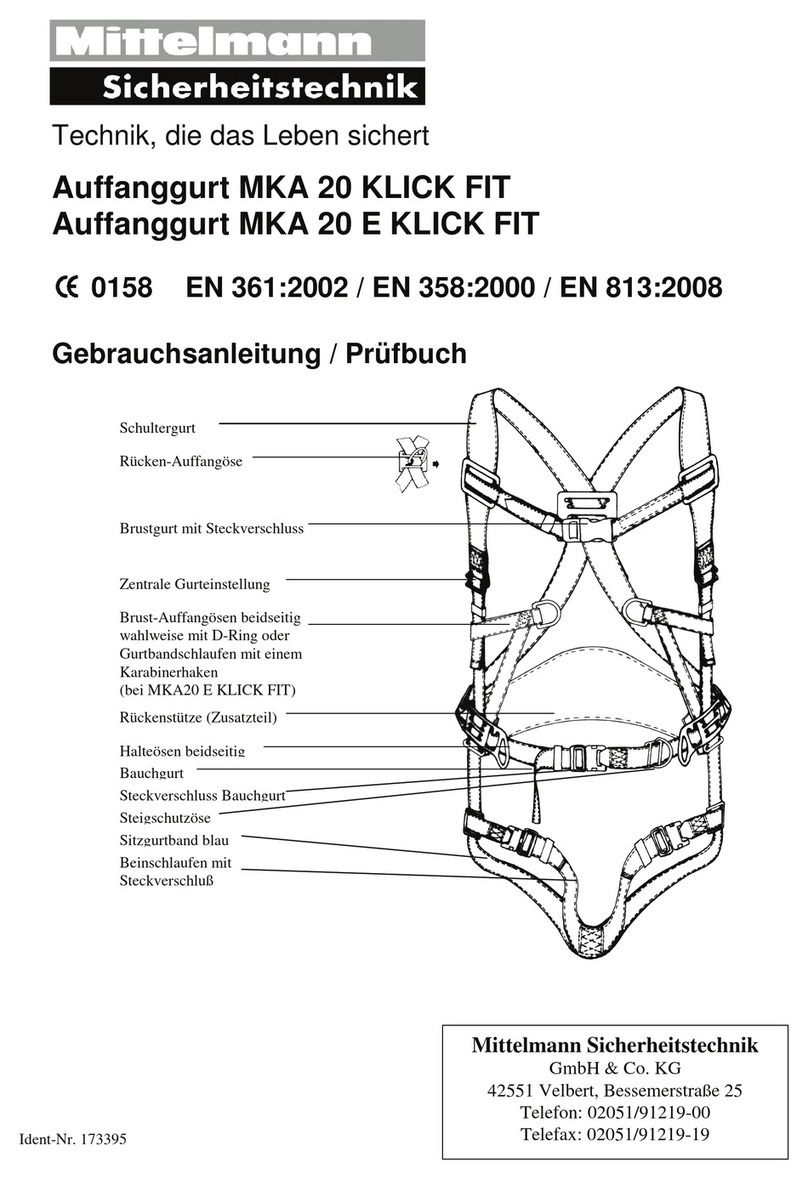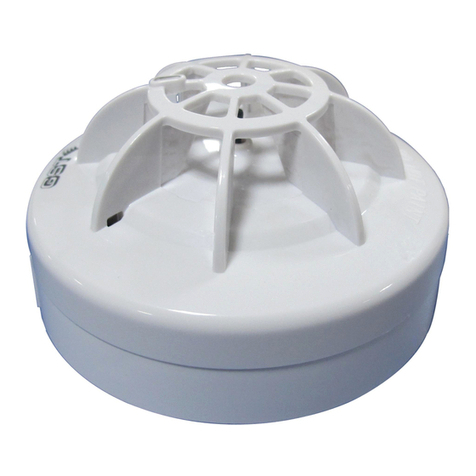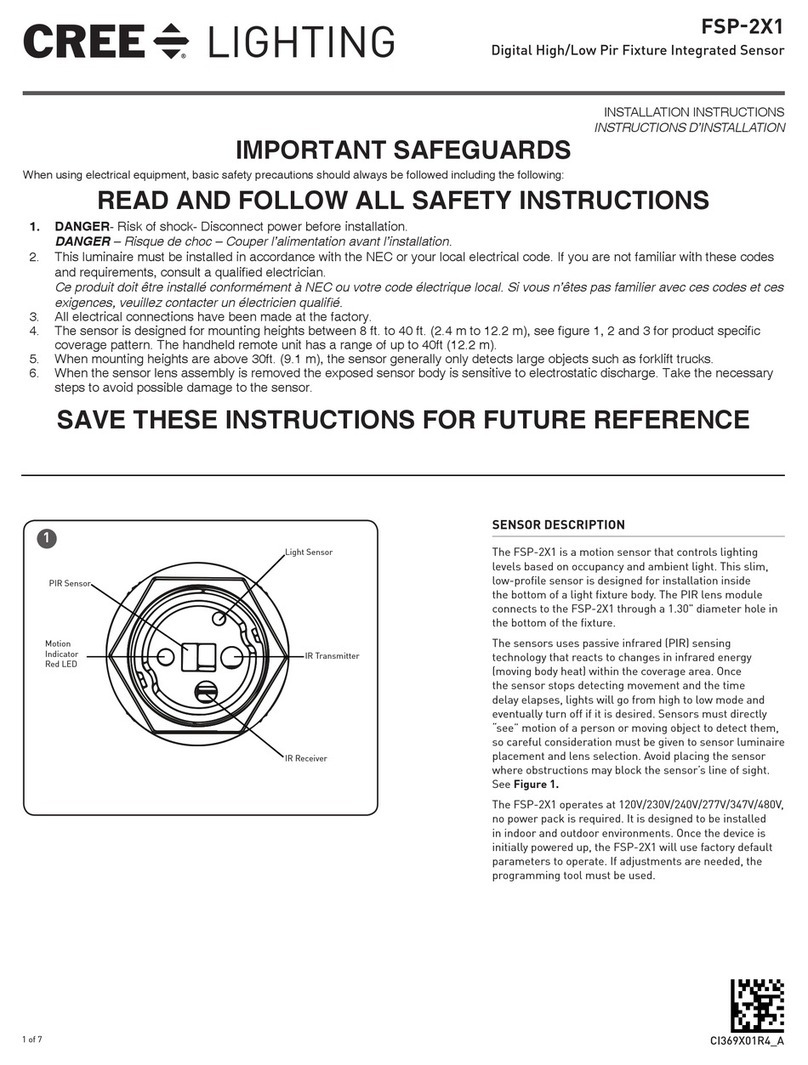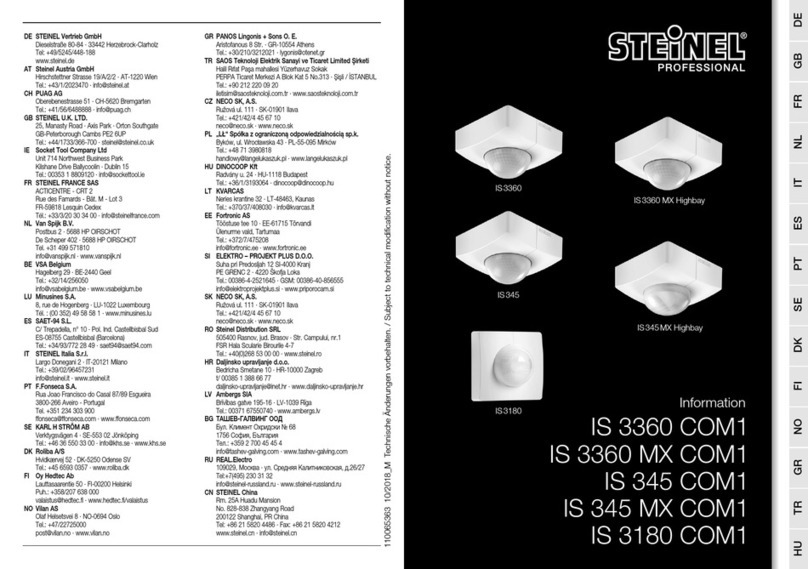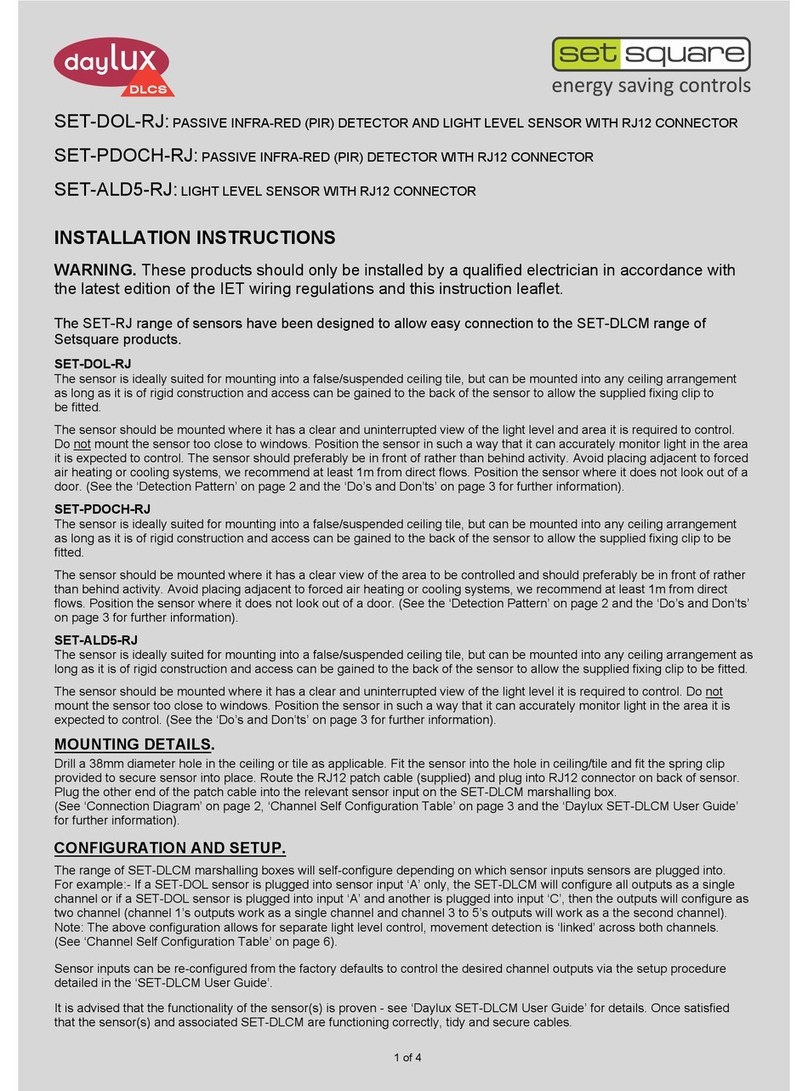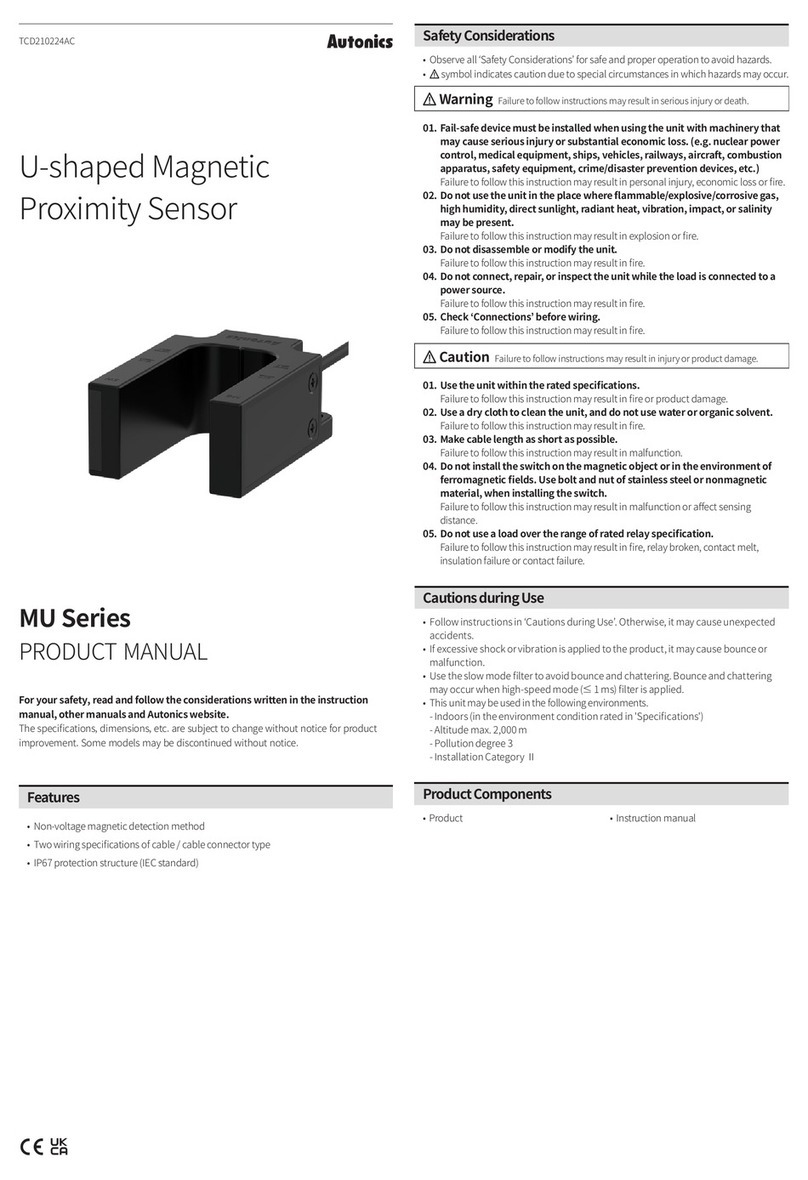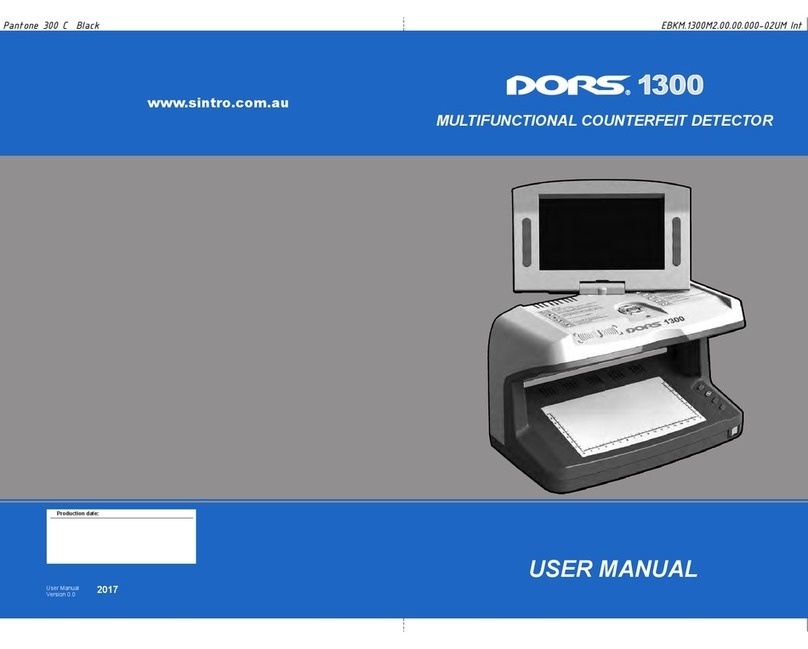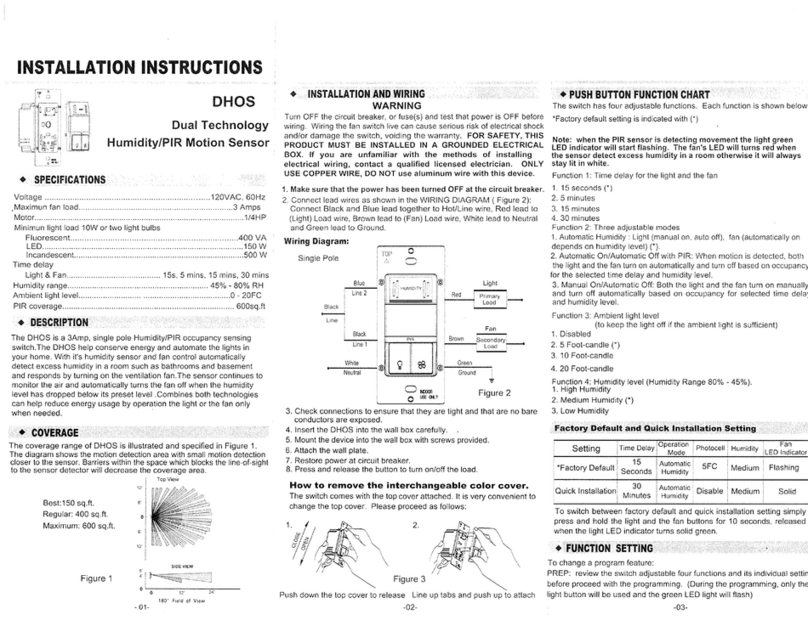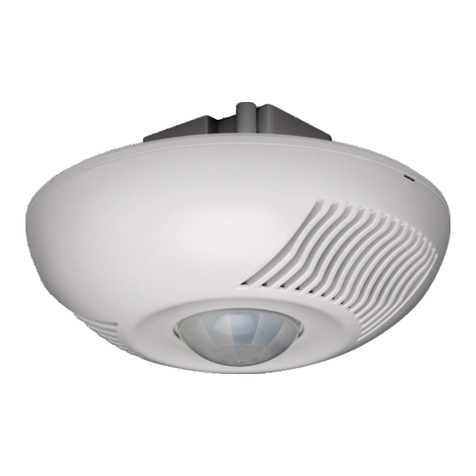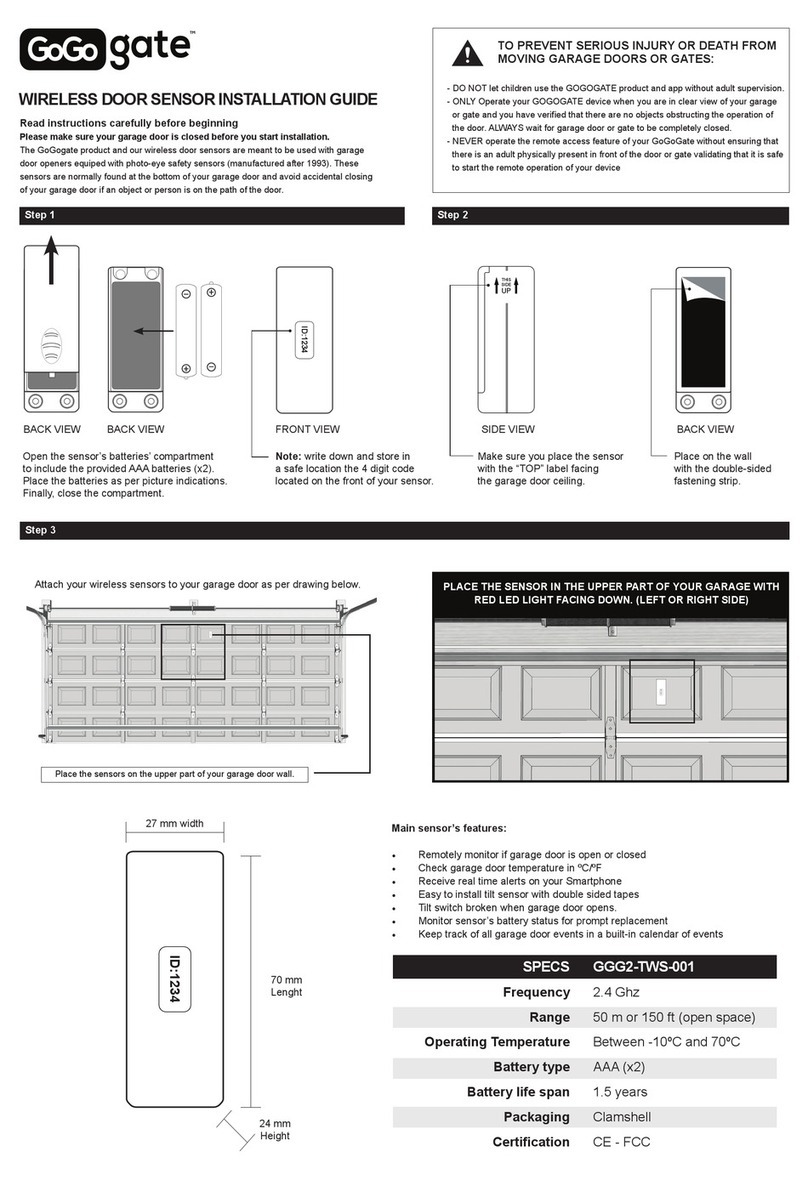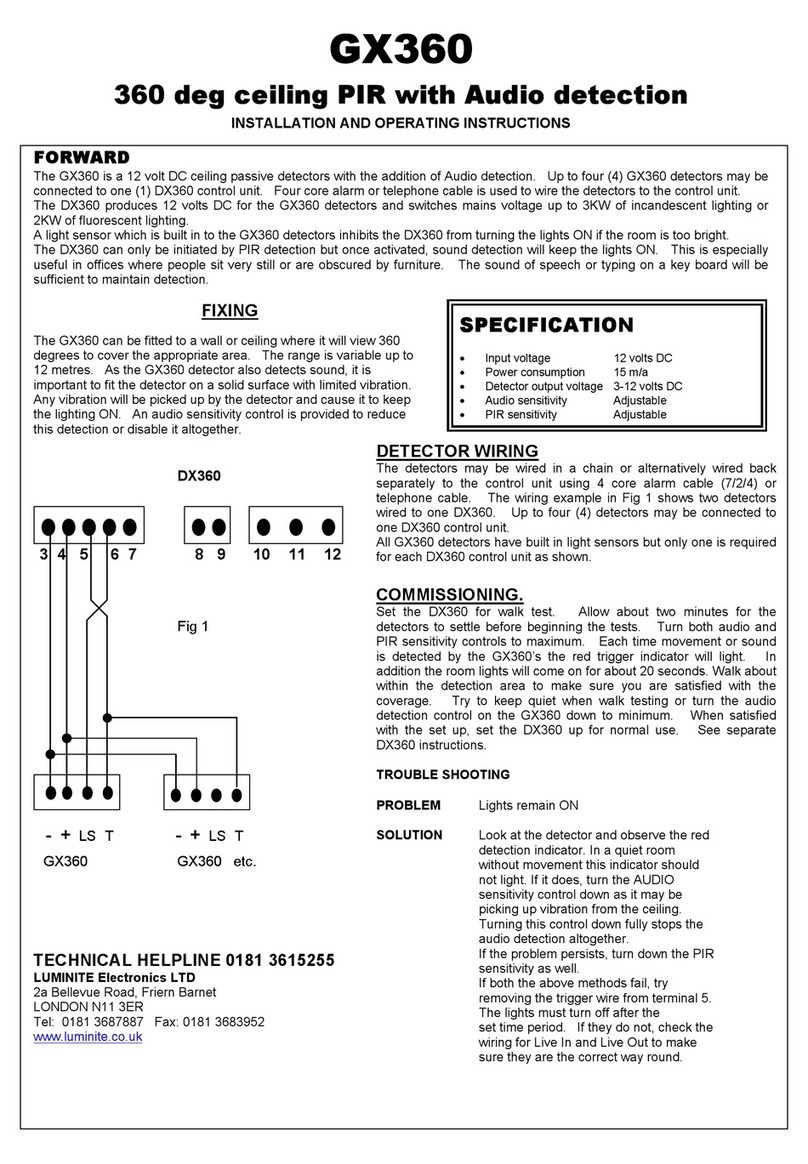Orno OR-CR-207 User manual

OR-CR-207
(PL) Czujnik ruchu
(EN) Motion sensor
(DE) Bewegungssensor
ORNO-LOGISTIC Sp. z o.o.
ul. Rolników 437
44-141 Gliwice POLAND
tel. (+48) 32 43 43 110
WAŻNE!
Przed rozpoczęciem korzystania z urządzenia, należy zapoznać się z niniejszą instrukcją obsługi oraz zachować ją na przyszłość. Dokonanie samodzielnych napraw i
modyfikacji skutkuje utratą gwarancji. Producent nie odpowiada za uszkodzenia mogące wyniknąć z nieprawidłowego montażu czy eksploatacji urządzenia.
Z uwagi na fakt, że dane techniczne podlegają ciągłym modyfikacjom, Producent zastrzega sobie prawo do dokonywania zmian dotyczących charakterystyki wyrobu
oraz wprowadzania innych rozwiązań konstrukcyjnych niepogarszających parametrów i walorów użytkowych produktu.
Dodatkowe informacje oraz wsparcie techniczne związane z produktem dostępne na: www.support.orno.pl. Orno-Logistic Sp. z o.o. nie ponosi odpowiedzialności za
skutki wynikające z nieprzestrzegania zaleceń niniejszej instrukcji. Firma Orno-Logistic Sp. z o.o. zastrzega sobie prawo do wprowadzania zmian w instrukcji - aktualna
wersja do pobrania ze strony www.support.orno.pl. Wszelkie prawa do tłumaczenia/interpretowania oraz prawa autorskie niniejszej instrukcji są zastrzeżone.
1. Instalacji musi dokonywać elektryk lub osoba doświadczona.
2. Wszelkie czynności wykonuj przy odłączonym zasilaniu. W tym celu odłącz bezpieczniki.
3. Nie zanurzaj urządzenia w wodzie i innych płynach.
4. Nie obsługuj urządzenia gdy uszkodzona jest obudowa.
5. Nie otwieraj urządzenia i nie dokonuj samodzielnych napraw.
6. Nie używaj urządzenia niezgodnie z jego przeznaczeniem.
IMPORTANT!
Before using the device, read this Service Manual and keep it for future use. Any repair or modification carried out by yourselves results in loss of guarantee. The
manufacturer is not responsible for any damage that can result from improper device installation or operation.
In view of the fact that the technical data are subject to continuous modifications, the manufacturer reserves a right to make changes to the product characteristics
and to introduce different constructional solutions without deterioration of the product parameters or functional quality.
Additional information and technical support related to the product is available at www.support.orno.pl. Orno-Logistic Sp. z o.o. holds no responsibility for the results
of non-compliance with the provisions of the present Manual. Orno Logistic Sp. z o.o. reserves the right to make changes to the Manual - the latest version of the
Manual can be downloaded from www.support.orno.pl. Any translation/interpretation rights and copyright in relation to this Manual are reserved.
1. Installation must be carried out by an electrician or an experienced person.
2. Disconnect the power supply before any activities on the product.
3. Do not immerse the device in water or other fluids.
4. Do not operate the device when its housing is damaged.
5. Do not open the device and do not repair it by yourselves.
6. Do not use the device against its intended use.
WICHTIG!
Bevor Sie das Gerät in Betrieb nehmen, lesen Sie bitte diese Bedienungsanleitung und bewahren Sie sie zum späteren Nachschlagen auf. Eigene Reparaturen und
Modifikationen führen zum Verlust der Garantie. Der Hersteller haftet nicht für Schäden, die durch unsachgemäße Montage oder Bedienung des Gerätes entstehen
können.
Da die technischen Daten ständigen Änderungen unterliegen, behält sich der Hersteller das Recht vor, Änderungen an den Produkteigenschaften vorzunehmen und
andere konstruktive Lösungen einzuführen, die die Parameter und funktionellen Eigenschaften des Produkts nicht beeinträchtigen.
Weitere Informationen und technische Unterstützung zu diesem Produkt finden Sie unter: www.support.orno.pl. Orno-Logistic Sp. z o.o. haftet nicht für die Folgen der
Nichtbeachtung der Anweisungen in dieser Bedienungsanleitung. Firma Orno-Logistic Sp. z o.o. behält sich das Recht vor, Änderungen in der Bedienungsanleitung
vorzunehmen - aktuelle Version zum Herunterladen unter www.support.orno.pl. Alle Rechte an Übersetzung/Dolmetschen und Urheberrechten an dieser
Bedienungsanleitung sind vorbehalten.
1. Die Montage darf Elektriker oder eine erfahrene Person durchführen.
2. Alle Arbeiten führen Sie bei ausgeschalteter Stromversorgung aus. Schalten Sie die Sicherungspatronen aus.
3. Tauchen Sie das Gerät nicht in das Wasser oder die anderen Flüssigkeiten.
4. Nutzen Sie das Gerät nicht, wenn sein Gehäuse beschädigt ist.
5. Öffnen Sie das Gerät nicht und nehmen Sie selbständig keine Reparaturen vor.
6. Nutzen Sie das Gerät seinem Zweck entsprechend.
Każde gospodarstwo jest użytkownikiem sprzętu elektrycznego i elektronicznego, a co za tym idzie potencjalnym wytwórcą niebezpiecznego dla ludzi i środowiska odpadu, z tytułu
obecności w sprzęcie niebezpiecznych substancji, mieszanin oraz części składowych. Z drugiej strony zużyty sprzęt to cenny materiał, z którego możemy odzyskać surowce takie jak
miedź, cyna, szkło, żelazo i inne.
Symbol przekreślonego kosza na śmieci umieszczany na sprzęcie, opakowaniu lub dokumentach do niego dołączonych oznacza, że produktu nie wolno wyrzucać łącznie z innymi
odpadami. Oznakowanie oznacza jednocześnie, że sprzęt został wprowadzony do obrotu po dniu
13 sierpnia 2005 r. Obowiązkiem użytkownika jest przekazanie zużytego sprzętu do wyznaczonego punktu zbiórki w celu właściwego jego przetworzenia. Informacje o dostępnym
systemie zbierania zużytego sprzętu elektrycznego można znaleźć w punkcie informacyjnym sklepu oraz w urzędzie miasta/gminy. Odpowiednie postępowanie ze zużytym sprzętem
zapobiega negatywnym konsekwencjom dla środowiska naturalnego i ludzkiego zdrowia!
Each household is a user of electrical and electronic equipment, and hence a potential producer of hazardous waste for humans and the environment, due to the presence of hazardous
substances, mixtures and components in the equipment. On the other hand, used equipment is valuable material from which we can recover raw materials such as copper, tin, glass,
iron and others. The weee sign placed on the equipment, packaging or documents attached to it indicates the need for selective collection of waste electrical and electronic equipment.
Products so marked, under penalty of fine, cannot be thrown into ordinary garbage along with other waste. The marking means at the same time that the equipment was placed on the
market after August 13, 2005. It is the responsibility of the user to hand the used equipment to a designated collection point for proper processing. Used equipment can also be handed
over to the seller, if one buys a new product in an amount not greater than the new purchased equipment of the same type. Information on the available collection system of waste
electrical equipment can be found in the information desk of the store and in the municipal office or district office. Proper handling of used equipment prevents negative consequences
for the environment and human health!
Jeder Haushalt ist ein Anwender von Elektro- und Elektronikgeräten und damit ein potenzieller Erzeuger von Abfällen, die für Mensch und Umwelt aufgrund des Vorhandenseins von
gefährlichen Stoffen, Gemischen und Komponenten in den Geräten gefährlich sind. Andererseits sind Altgeräte ein wertvoller Rohstoff, aus dem Rohstoffe wie Kupfer, Zinn, Glas, Eisen
und andere zurückgewonnen werden können. Das Symbol der durchgestrichenen Mülltonne auf der Verpackung, dem Gerät oder den dazugehörigen Dokumenten, weist auf die
Notwendigkeit der getrennten Sammlung von Elektro- und Elektronikaltgeräten hin. Auf diese Weise gekennzeichnete Produkte dürfen unter Strafe nicht zusammen mit anderen
Abfällen entsorgt werden. Die Kennzeichnung weist gleichzeitig darauf hin, dass die Geräte nach dem 13 August 2005 in Verkehr gebracht wurden. Es liegt in der Verantwortung des
Benutzers, die Altgeräte zur ordnungsgemäßen Behandlung an eine dafür vorgesehene Sammelstelle zu bringen. Informationen über das verfügbare System zur Sammlung von
Elektroaltgeräten finden Sie in der Informationsstelle des Ladens und im Magistrat/Gemeindeamt. Ein sachgemäßer Umgang mit Altgeräten verhindert negative Folgen für die Umwelt
und die menschliche Gesundheit!
03/2021

2
SKRÓCONA INSTRUKCJA OBSŁUGI/ QUICK GUIDE/ KURZANLEITUNG
61,5 mm
76 mm
75,6 mm
60 mm
L- Napięcie wyjściowe/ Output voltage/Ausgangsspannung
N - Zacisk neutralny/ Neutral terminal/ Neutrale Klemme
L- Napięcie wejściowe/ Input voltage/ Eingangsspannung
- Obciążenie/load/Belastung
rys.1/ fig.1/ Abb.1
rys.2/ fig.2/ Abb.2
rys.3/ fig.3/ Abb.3
rys.4/ fig.4/ Abb.4
rys.5/ fig.5/ Abb.5
rys.6/ fig.6/ Abb.6
SPECYFIKACJA TECHNICZNA/ TECHNICAL DATA/ TECHNISCHE DATEN
Zasilanie
Power supply
Stromversorgung
230V~, 50Hz
Max. obciążenie
Max. load
Max. Belastung
1200W 300W
Pobór prądu
Power consumption
Stromaufnahme
0,45W/ 0,1W
Kąt detekcji czujnika
Detection angle
Erfassungswinkel
360°
Regulacja czujnika natężenia światła
Adjustable daylight sensor
Einstellbarer Tageslichtsensor
<3-2000 lux
Regulacja czasu świecenia
Adjustable time setting
Einstellbare Leuchtdauer
min. 10sek.±3sek.
max.15min.±2min.
Zasięg detekcji czujnika
Detection range
Erfassungsbereich
max. 6m (<240C)
Stopień ochrony
Protection level
Schutzart
IP20
Waga netto
Net weight
Nettogewicht
0,1kg
Temp. pracy
Working temperature
Betriebstemperatur
-200C-400C
Wysokość montażu
Installation height
Montagehöhe
2,2-4m
Współpracuje z LED
Works with LED
Arbeitet mit LED
✓
Czujnik obecności
Presence sensor
Anwesenheitssensor
Przekaźnik
Relay
Relais
✓
PL
Instrukcja obsługi
CHARAKTERYSTYKA
Czujnik jest przystosowany do montażu w sufitach podwieszanych. Służy do automatycznego sterowania oświetleniem (włączania i wyłączania) lub innymi urządzeniami elektrycznymi przy
jednoczesnej oszczędności energii elektrycznej. Oświetlenie jest włączane za pomocą czujnika ruchu PIR, który działa na podczerwień. Czujnik posiada regulację czasu działania (TIME) oraz natężenia
światła (LUX).
OGÓLNE INFORMACJE
Przed wybraniem miejsca montażu czujnika należy wziąć pod uwagę poniższe uwagi:
- wysokość montażu 2,2 - 4 m;
- unikać montowania w sąsiedztwie urządzeń wytwarzających ciepło np. grzejniki, klimatyzatory;
- nie zaleca się instalowania czujnika naprzeciwko powierzchni silnie odbijających światło takich jak np. lustra itp.;
- nie montować w zasięgu jasnego źródła światła;
- czujnik nie powinien znajdować się blisko urządzeń emitujących silne pole elektromagnetyczne.
- unikać kierowania czujnika w kierunku obiektów, które mogą być poruszane np. wiatrem, jak zasłony, wysokie rośliny itp.
INSTALACJA
1. Rozłącz obwód zasilania.
2. Sprawdź odpowiednim przyrządem stan beznapięciowy na przewodach zasilających.
3. Zdejmij przezroczystą pokrywę winylową.
4. Poluzuj śruby w kostce zaciskowej, a następnie podłącz zasilanie i wszystkie przewody elektryczne zgodnie ze schematem podłączenia przewodów (rys.2).
5. Odegnij metalową sprężynę czujnika do gory, aż znajdzie się w położeniu “I”z czujnikiem, następnie włóż czujnik do otworu w suficie lub do puszki instalacyjnej o takim samym rozmiarze jak
czujnik. Po zwolnieniu sprężyny, czujnik zostanie zamontowany.
6. Po zakończeniu instalacji, włącz zasilanie I przetestuj czujnik.

3
TEST
Czujnik wyposażony jest w dwa pokrętła:
TIME - umożliwia określenie czasu przez jaki urządzenie będzie działało po aktywacji czujnika, czas świecenia czujnika jest regulowany: min czas świecenia to 10 sek±3 sek; max czas świecenia to 12
min ±3 min.
LUX - umożliwia ustawienie poziomu natężenia oświetlenia, przy którym czujnik będzie mógł uaktywnić urządzenie do niego podłączone, zabezpiecza to przed niepożądanym włączaniem oświetlenia
podczas dnia, poziom natężenia światła przy jakim czujnik zaczyna wykrywać ruch jest regulowany od 3 do 2000 lux.
Ustaw pokrętło “TIME” w pozycji przeciwnej do ruchu wskazówek zegara (10S) a pokrętło “LUX” w kierunku zgodnym z ruchem wskazówek zegara na maximum .
Włącz zasilanie. Czujnik i połączone do niego oświetlenie na początku nie odnajdą sygnału.
Po ok. 30 sekundach czujnik powinien rozpocząć pracę. Jeśli czujnik wychwyci sygnał, oświetlenie się włączy. Jeśli sygnał ustanie, odbiornik powinien przestać pracować w ciągu 10s ± 3s,
a oświetlenie wyłączyć się.
Przekręć pokrętło LUX w kierunku przeciwnym do ruchu wskazówek zegara, na minimum (3). Jeśli natężenie światła otoczenia jest większe niż 3 LUX, czujnik przestanie działać i oświetlenie również.
Jeśli natężenie światła otoczenia jest mniejsze niż 3 LUX (ciemność), czujnik zacznie pracować.
W przypadku braku sygnału, czujnik powinien przestać pracować w ciągu 10 s ± 3 s.
Uwaga: Podczas przeprowadzania testu czujnika w dzień pokrętło LUX należy ustawić na pozycję MAX w przeciwnym razie czujnik nie będzie działał prawidłowo!
NIEKTÓRE PROBLEMY I SPOSOBY ICH ROZWIĄZANIA
Obciążenie nie działa:
a. Sprawdzić podłączenie zasilania i odbiornika.
b. Sprawdź odbiornik.
c. Sprawdź ustawienia natężenia oświetlenia otoczenia.
Słaba czułość:
a. Sprawdzić, czy przed czujnikiem nie znajdują się urządzenia, które mogą zakłócić odbierane sygnały.
b. Sprawdź temperaturę otoczenia.
c. Sprawdź, czy wykrywany obiekt znajduje się w polu detekcji.
d. Sprawdź wysokość instalacji.
e. Sprawdź czy kierunek orientacji czujnika jest poprawny.
Czujnik nie może automatycznie wyłączyć obciążenia:
a. W polu detekcji występują ciągłe sygnały ruchu.
b. Sprawdź czy opóźnienie czasowego nie jest ustawione na najdłuższą wartość.
c. Sprawdź czy zasilanie jest zgodne z instrukcją.
BEZPIECZEŃSTWO I KONSERWACJA
Konserwacji dokonywać przy odłączonym zasilaniu.
Czyścić wyłącznie delikatnymi i suchymi tkaninami.
Nie używać chemicznych środków czyszczących.
Nie zakrywać urządzenia.
Montować z dala od źródeł ciepła.
EN
Operating and installation instructions
DESCRIPTION
The sensor is suitable for installation in suspended ceilings. The sensor is used to automatically control lighting (switching on and off) or other electrical devices, that helps to save electricity. The
receiver (lighting) is switched on by means of the PIR motion sensor that is the passive infrared sensor. The sensor has adjustable operating time (TIME) and light intensity (LUX).
GENERAL REMARKS
While choosing a place of installation, consider the following criteria:
- height of installation: 2.2-4 m;
- do not install the device nearby heaters, fans and other objects where the temperature can change rapidly,
- it is not recommended to install the sensor opposite to highly reflective surfaces such as mirrors etc;
- do not install within the range of a bright light source;
- do not install in the vicinity of strong sources of electromagnetic interference,
- avoid directing the sensor towards objects that can be moved by the wind, such as curtains, tall plants, etc.
INSTALLATION
1. Disconnect power source.
2. Check with a suitable instrument that there is no voltage on the power leads.
3. Remove the transparent vinyl cover.
4. Loosen the screws in the terminal block and then connect the power supply and all electrical wires according to the wiring diagram (fig.2).
5. Bend the sensor's metal spring upwards until it is in position "I" with the sensor, then insert the sensor into a hole in the ceiling or into an installation box of the same size as the sensor. When the
spring is released, the sensor will be installed.
6. After installation, turn on the power and test the sensor.
TEST
The sensor is equipped with two knobs:
TIME –allows to specify the time of the device operation after the sensor activation, the sensor's light time is adjustable: min lighting time is 10 sec ±3 sec; max lighting time is 15 min ±2 min.
LUX - allows you to set the level of light intensity at which the sensor will activate the device connected to it, this prevents unwanted switching on of lighting during the day, the level of light
intensity at which the sensor starts detecting movement is adjustable from 3 to 2000 lux.
Turn the "TIME" knob counterclockwise (10sec) and the "LUX" knob clockwise to maximum .
Turn on the power. The sensor and the lighting connected to it will not find a signal at first.
After approx. 30 seconds the sensor should start working. If the sensor detects a signal, the lighting switches on. If the signal stops, the receiver should stop working within 10s ± 3s and the lighting
switches off.
Turn the LUX knob counterclockwise to minimum (3). If the ambient light intensity is exceeded 3 LUX, the sensor will stop working and the lighting will also stop. If the ambient light intensity is less
than 3 LUX (darkness), the sensor will start operating.
If there is no signal, the sensor should stop working within 10 s ± 3 s.
Note: when testing in daylight, please turn LUX knob to (MAX ) position, otherwise the sensor could not work properly!
SOME PROBLEMS AND SOLUTIONS
The load does not work:
a. Please check if the connection of power source and load is correct.
b. Please check if the load is good.
c. Please check if the settings of working light correspond to ambient light.
The sensitivity is poor:
a. Please check if there is any hindrance in front of the detector to affect it to receive the signals.
b. Please check if the ambient temperature is correct.
c. Please check if the induction signal source is in the detection field.
d. Please check if the installation height corresponds to the height required in the instruction.
e. Please check that the orientation of the sensor is correct.
The sensor can not shut off the load automatically:
a. Please check if there is continual signal in the detection field.
b. Please check if the time delay is set to the maximum position.

4
c. Please check if the power corresponds to the instruction.
SAFETY AND MAINTENANCE
Maintenance should be carried out with power disconnected.
Clean only with delicate and dry fabrics.
Do not use chemical cleaners.
Do not cover the product.
Install away from heat sources.
DE
Bedienungsanleitung und Montageanleitung
BESCHREIBUNG UND ANWENDUNG
Der Sensor eignet sich zur Montage an Zwischendecken. Der Sensor dient zur automatischen Steuerung der Beleuchtung (Ein- und Ausschalten) oder anderen elektrischen Geräten bei gleichzeitigen
Stromeinsparungen. Die Beleuchtung wird mit dem Passiv-Infrarot-Bewegungssensor PIR eingeschaltet. Der Sensor verfügt über die einstellbare Betriebszeit (TIME) und die einstellbare Lichtstärke
(LUX).
ALLGEMEINE ANGABEN
Vor der Wahl der Befestigungsstelle soll man folgende Hinweisen berücksichtigen:
- höhe der Montage 2,2 - 4 m;
- man soll den Sensor nicht in der Nähe von Geräten, die die Wärme abgeben - z. B. Heizkörper oder Klimaanlagen, anbringen;
- wir abraten, den Sensor gegenüber den Oberflächen, die das Licht stark zurückwerfen, wie: z. B. Spiegel etc.;
- man soll den Sensor nicht in der Nähe von Quelle eines hellen Lichtes anbringen;
- der Sensor soll sich nicht in der Nähe von Geräten, die ein starkes elektromagnetisches Feld erzeugen, befinden.
- man soll vermeiden, den Sensor auf die Objekte, die z. B. Wind bewegt kann, zu richten, z. B.: Vorhänge, hohe Pflanzen etc.
MONTAGE
1. Trennen Sie den Schaltkreis von der Spannungsversorgung.
2. Prüfen Sie mit einem geeigneten Werkzeug den spannungsfreien Zustand an den Versorgungskabeln.
3. Nehmen Sie die transparente Vinylabdeckung ab.
4. Lösen Sie die Schrauben des Klemmenblockes, schließen Sie die Stromversorgung und alle elektrischen Leitungen gemäß dem Anschluss-Schema für Leitungen an.
5. Biegen Sie die Metallfeder des Sensors nach oben, bis sie sich in der Stellung „I“ befindet und stecken Sie den Sensor ins Loch in der Decke oder in die Einbaudose, derer Abmessungen den
Abmessungen des Sensors entsprechen, hinein. Lassen Sie die Feder frei, wird der Sensor montiert.
6. Sind Sie mit der Montage fertig, schließen Sie die Stromversorgung an und testen Sie den Sensor.
TEST
Der Sensor verfügt über zwei Drehknöpfe:
TIME - ermöglicht, die Zeit des Betriebes des Gerätes nach der Aktivierung des Sensors, Leuchtzeit ist einstellbar: Min. Leuchtzeit - 10 s ± 3 s.; Max. Leuchtzeit - 15 Min. ±2 Min.
LUX - ermöglicht die Einstellung der Lichtstärke, bei der der Sensor das an ihm angeschlossene Gerät einschaltet, dies sichert, dass das Licht am Tag nicht eingeschaltet wird. Die Lichtstärke, die dem
Sensor die Bewegungsdetektion ermöglicht, kann man von 3 bis zu 2000 lux einstellen.
Drehen Sie den Drehknopf „TIME“ entgegen dem Uhrzeigersinn (10S) und den Drehknopf „LUX“ im Uhrzeigesinn und stelle Sie ihn auf Maximum ein.
Schließen Sie die Stromversorgung an. Der Sensor und die an ihn angeschlossene Beleuchtung erfasst am Anfang kein Signal. Nach ca. 30 Sekunden soll der Sensor richtig funktionieren. Erfasst der
Sensor ein Signal, schaltet die Beleuchtung ein. Endet das Signal, wird das Empfangsgerät innerhalb von 10s ± 3s außer Betrieb gesetzt und die Beleuchtung schaltet aus..
Drehen Sie den Drehknopf „LUX“ entgegen dem Uhrzeigersinn und stellen Sie ihn auf den Minimum ein. (3). Ist die Lichtstärke der Umgebung größer als 3 Lux, werden der Sensor und die
Beleuchtung aus Betrieb gesetzt. Ist die Lichtstärke der Umgebung kleiner als 3 Lux (Dunkelheit), schalten der Sensor wieder ein.
Gibt es kein Signal, soll der Sensor innerhalb von 10 s ± 3 s funktionieren.
Achtung: Wenn Sie das Gerät bei Tageslicht testen, drehen Sie den LUX-Knopf auf die Position (SUN ), sonst funktioniert der Sensor nicht richtig!
EINIGE PROBLEME UND DEREN LÖSUNGEN
Die Last funktioniert nicht:
a. Überprüfen Sie die Stromversorgung und den Anschluss des Empfängers.
b. Überprüfen Sie den Empfänger.
c. Überprüfen Sie die Sensoreinstellungen und die Einstellungen der Lichtintensität der Umgebung.
Schlechte Empfindlichkeit:
a. Überprüfen Sie, ob sich vor dem Sensor keine Geräte befinden, die die empfangenen Signale stören könnten.
b. Überprüfen Sie die Umgebungstemperatur.
c. Überprüfen Sie, ob sich das zu erkennende Objekt im Erkennungsbereich befindet.
d. Überprüfen Sie die Höhe der Installation.
e. Prüfen Sie, ob die Ausrichtung des Sensors richtig ist.
Der Sensor kann die Last nicht automatisch abschalten:
a. Im Erfassungsbereich liegen kontinuierliche Bewegungssignale vor.
b. Überprüfen Sie, ob die Zeitverzögerung nicht auf den längsten Wert eingestellt ist.
c. Überprüfen Sie, ob die Stromversorgung mit der Bedienungsanleitung übereinstimmt.
SICHERHEIT UND WARTUNG
Wartung soll bei ausgeschalteter Stromversorgung erfolgen.
Reinigen Sie ausschließlich mit den sanften und trockenen Stoffen.
Nutzen Sie keine chemischen Reinigungsmittel.
Decken Sie das Gerät nicht.
Bringen Sie das Gerät nicht in der Nähe von Wärmequellen.
Table of contents
Other Orno Security Sensor manuals
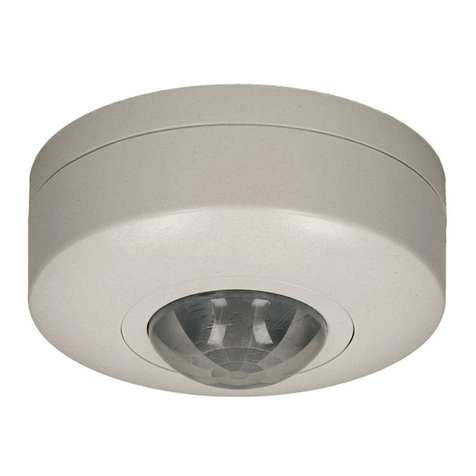
Orno
Orno OR-CR-249 User manual

Orno
Orno OR-AK-1202 User manual
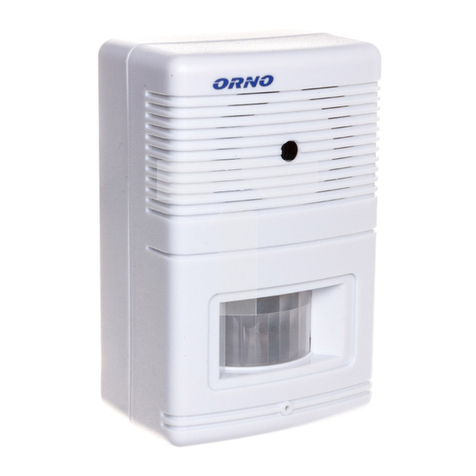
Orno
Orno OR-MA-701 User manual
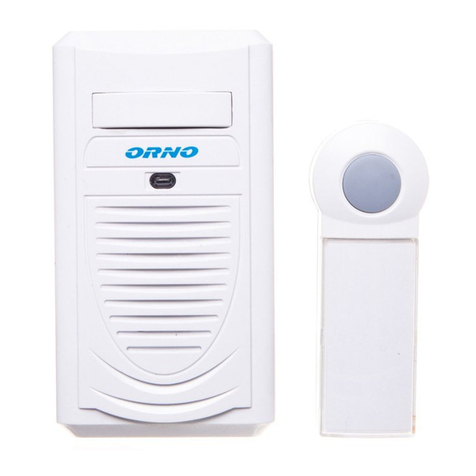
Orno
Orno OR-DB-KH-123 User manual

Orno
Orno OR-CR-216 User manual
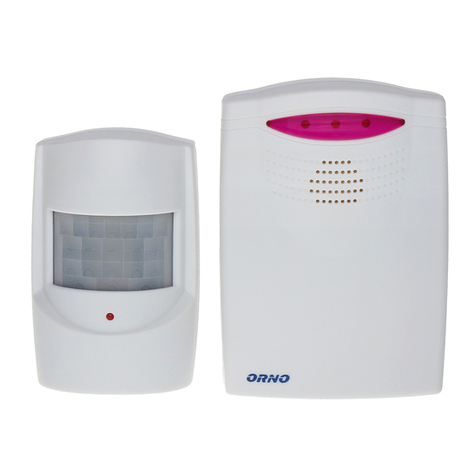
Orno
Orno OR-MA-705: OR-MA-710 User manual

Orno
Orno OR-DC-619 User manual

Orno
Orno OR-CR-250 User manual
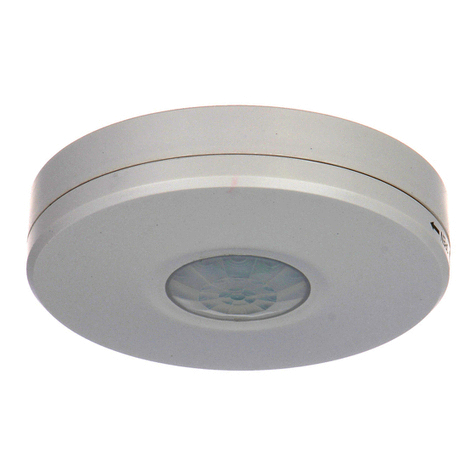
Orno
Orno OR-CR-264 User manual
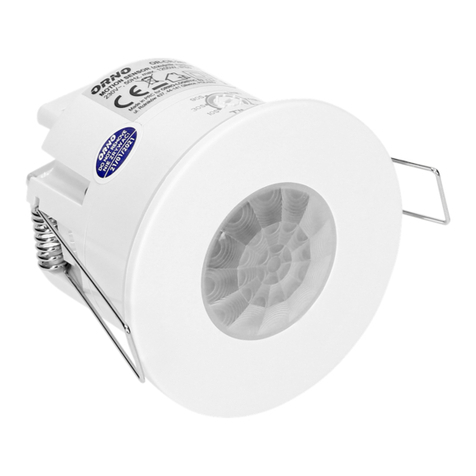
Orno
Orno OR-CR-267 User manual
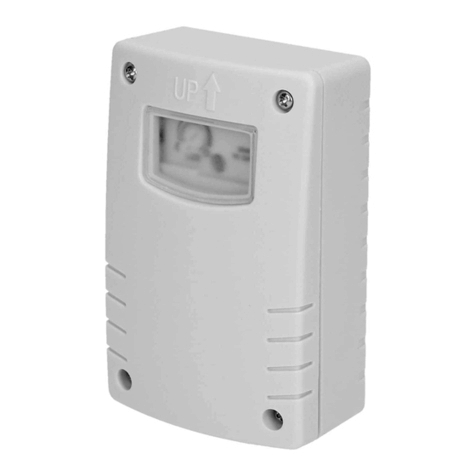
Orno
Orno OR-CR-209 User manual

Orno
Orno OR-MA-701 User manual
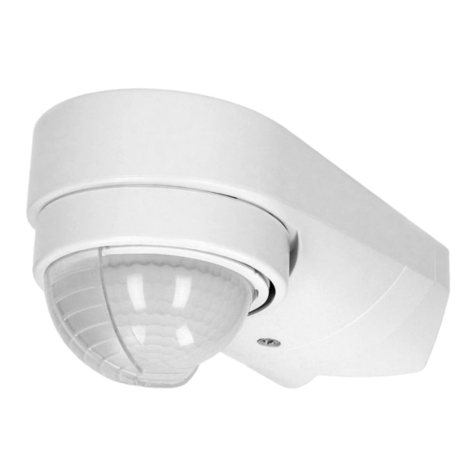
Orno
Orno OR-CR-265 User manual
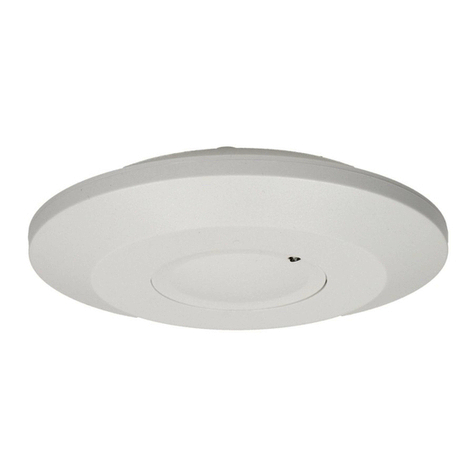
Orno
Orno OR-CR-240 User manual

Orno
Orno OR-AK-1210 Assembly instructions

Orno
Orno VIRONE DV-1 User manual
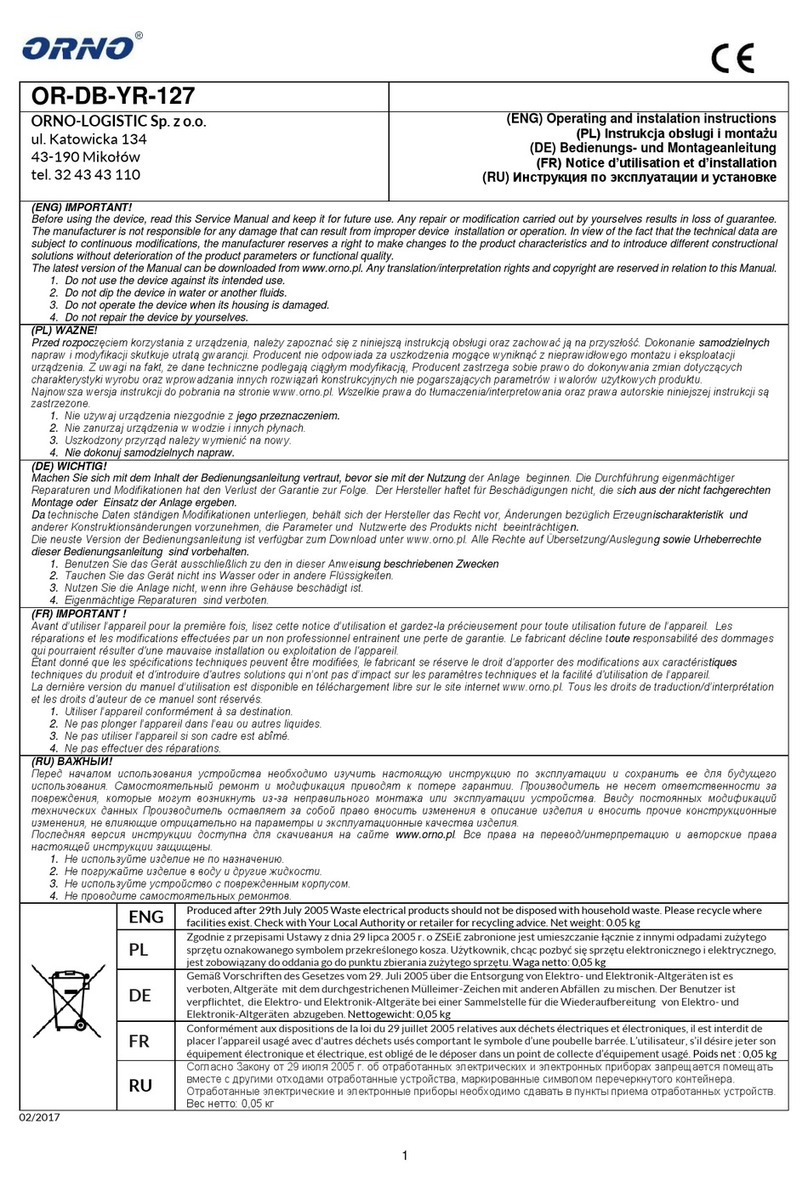
Orno
Orno OR-DB-YR-127 User manual
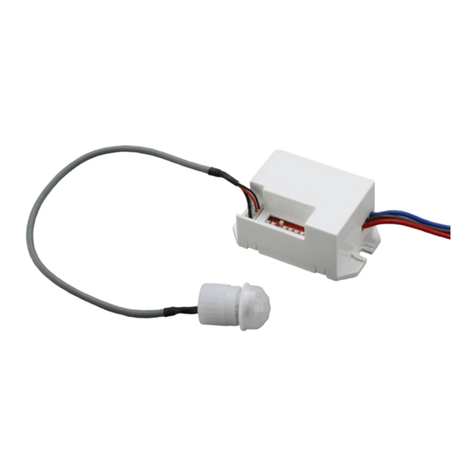
Orno
Orno OR-CR-211 User manual

Orno
Orno OR-MA-712 User manual

Orno
Orno OR-CR-220 User manual

